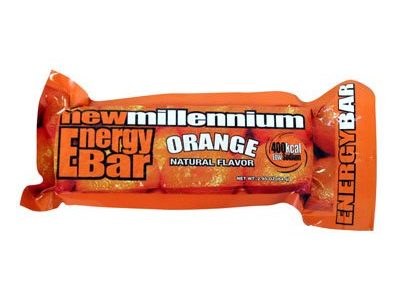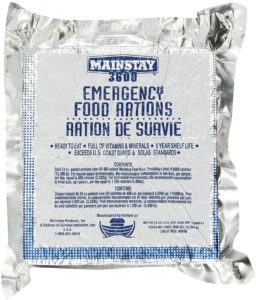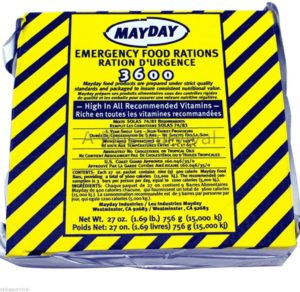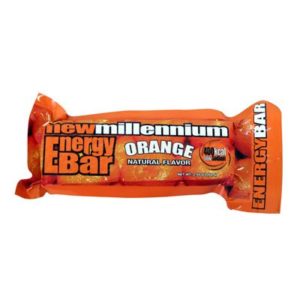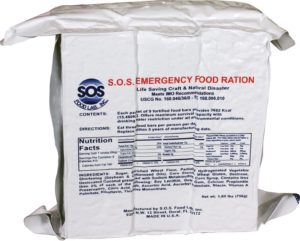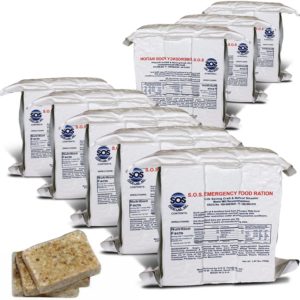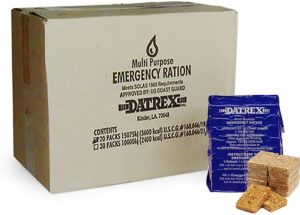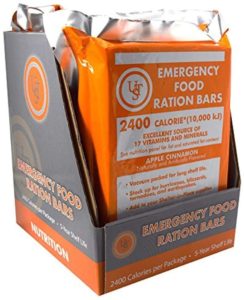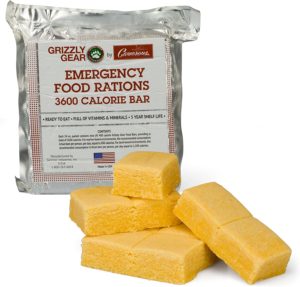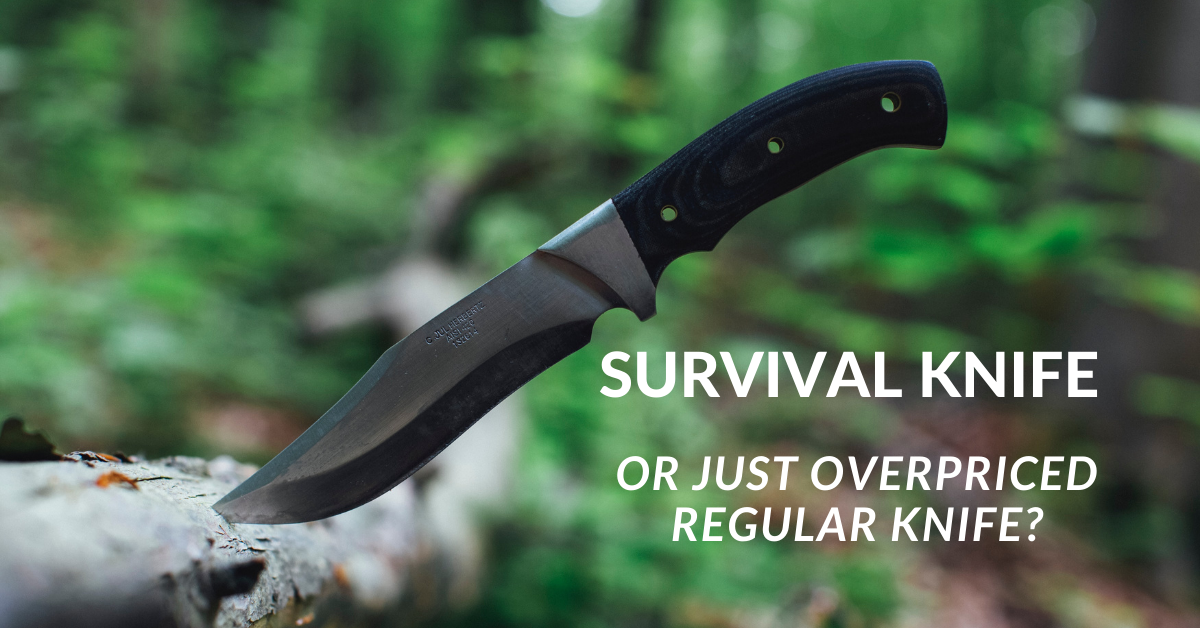Lifeboats are meant to keep you alive when an emergency occurs while onboard a ship.
As such, the lifeboat offers the required necessities by keeping you afloat and not starving, until you can access enough supply food and water rations.
Lifeboats are legally supposed to have approximately 10,300 KJ per person. Disaster preparedness is crucial and it's recommended to have disaster kits with survival tabs that provide essential nutrition to ensure survival during emergencies.
The dried survival food rations should be packed in an easily opened and readily divided manner, edible throughout their recommended life span, and palatable, while also providing adequate nutrition for long term food storage.
It is important to have meal varieties available to ensure a well-rounded diet during emergency situations.
There are no requirements when it comes to lifestyle or taste choices, but it is crucial to consider the nutritional value of the food being stored.
The rations are meant to provide your body with energy and nutrition to sustain you until you are rescued.
Below are some of the best lifeboat foods, including survival tabs, that have good taste and do not go bad quickly. These foods are also commonly found in disaster kits and outdoor camping emergency snowstorm earthquake disaster preparedness kits.
1. Mainstay bars
The mainstay bars are essential emergency food supplies for short-term survival. They have a lemon flavor and the best vitamins but lower protein content. Each bar contains enough calories for several servings.
Buy the Mainstay Emergency Lifeboat Food Ration Pack on Amazon for your disaster preparedness and camping needs.
This pack includes survival rations and tabs to ensure you have enough food in an emergency.
The mainstay potion, perfect for long term food storage, comes in large blocks that you can break into individual servings. They have a temperature range of between -40° F to 300 °F and a 5-year shelf-life, making it an ideal dried survival food that can last for hours.
Pros
-
Resilient packaging.
-
Low in sugar.
-
Good range of minerals and vitamins.
Cons
-
Low in protein content.
-
Portions are not individually wrapped.
2. Mayday’s emergency rations
The mayday rations come in various sized packs starting from a single serving 400-calorie up to a 3-day supply. In that way, it provides more flexibility than other lifeboat food options that usually comes in one or two sizes.
Buy Bug Out Emergency Food Bar on Amazon
Mayday's rations, also known as survival tabs, are one of the best-tasting dried survival food bars with a cinnamon and apple flavor. The mayday rations are an excellent addition to your emergency food supply, providing higher protein content to help you feel fuller.
However, they have limited minerals and vitamins, so they cannot be used for long-term emergency food supplies. The bars have a temperature range of between -22° F to 149 °F, making them a great option for any emergency situation.
Pros
-
Low in sugar
-
Decent flavor
-
Resilient packaging
-
Flexibility in a pack size
Cons
-
Limited minerals and vitamins
-
The portions are not individually wrapped.
3. Food labs Millennium bars
Millennium bars are individually packed, which makes them appear like sports bars.
They come in various flavors, including orange, tropical fruit, cherry, blueberry, raspberry, and lemon that make them more appealing not only to children but also to adults.
With a long 5 years shelf life long term food storage, these dried survival food items are perfect for emergency situations.
Each bar weighs an ounce, making them easy to carry in a backpack or emergency kit.
Purchase this Food Bar on Amazon
The millennium bars, perfect for survival food, have a variety of minerals and vitamins topped by sugar. With a long term food storage of years shelf life, each ounce of these bars can serve as survival tabs.
Pros
-
Fortified with vitamins
-
Different flavors
Cons
-
High in sugar
-
Costly
-
Take up more space
4. SOS ration bar
SOS provides their bars in both 3600 and 2400 calorie pack options and survival tabs for those who prefer a different type of emergency rations.
The bars have either cinnamon or coconut flavors, and each ounce of the food is packed with essential nutrients.
You can also subscribe to their service for regular deliveries of emergency food supplies.
The coconut flavored food bar has a similar taste to that of an animal cookie, and the cinnamon-flavored resemble a real cookie in both texture and taste.
The SOS emergency food ration bars use partially hydrogenated oils, which helps to save them from crumbling easily.
These rations are a great way to count on during emergencies, and you can even subscribe to receive them regularly.
Despite using cheaper ingredients, the SOS ration bars do not contain artificial flavoring in their cinnamon or coconut bars.
Each serving has an average sodium content of 15 g and 31g of sugar, making them a reliable option for emergency situations.
Pros
-
No artificial flavors
-
Less prone to crumbling
-
Extremely flavorful.
-
Individually wrapped servings.
Cons
-
Use of partially hydrogenated oils
-
High in sugar
5. Survival Frog 3600 Emergency food ration
The emergency survival frog rations are individually wrapped, with a block of bars vacuums bagged in rigid polymer foil.
These rations are designed to save lives in dire situations and can be easily stored in lifeboats for years.
Therefore, it's important to subscribe to our service and use the coupon code provided to ensure you always have access to fresh and resilient emergency rations.
Purchase the SOS Rations Here on Amazon
Every emergency ration bar has 400 calories; you can mix it with water or eat it solid to save time.
The food ration ingredients include coconut flavor, water, sugar, vegetable shortening, and floor.
You can count on the survival frog to provide a less sweet taste but will not compromise your energy levels.
Subscribe now for more information on our emergency rations.
Pros
No added vitamins
Cons
Difficult to unwrap the bars
6. Datrex 3600 emergency food bar
The lack of nuts, moderate pricing, and pleasant taste make the Date 3600 one of the lifeboat food options.
The Datrex bar is subdivided into 18 bars that have 200 calories each, making it perfect for rations emergencies.
The sub-packaging of the bars makes it easier to store and ration, and a total count of 3600 calories can sustain a person for a day.
Additionally, you can subscribe to receive regular delivery Tue of the Date 3600 bars.
However, one of the best things about the food bar is that no nuts and GMOs are used, making it the best for most people.
Get the Datrex 3600 Emergency Food Bar Pack Here
Unfortunately, if you are allergic to tree nuts, this food bar would not be the best for you.
Also, the food bar does not have preservatives. Its main ingredients include coconut, salt, water, cane sugar, vegetable shortening, and wheat flour.
Its five-year life span ensures that you can save it as rations emergency for a year after buying it.
You can also subscribe for free delivery to ensure that you always have access to this long-lasting food option.
Pros
-
Relatively lightweight
-
Economical pricing
Cons
-
Crumbly
-
Not meant for people who are allergic to tree nuts.
7. UST emergency food ration bars
The Ultimate Survival Technologies (UST) is a newcomer lifeboat food ration that has combined a pretty good tasting bar.
The bars have a 2400 calorie pack and apple cinnamon flavor, making it a perfect emergency rations for outdoor enthusiasts.
If you subscribe to their newsletter, you can save up to 10% on your next purchase of these delicious stars.
Although the UST bars are dry in composition, they are thirst-provoking, implying that you can eat them without feeling like you want to drink water.
When it comes to consistency, the UST bars are dense and not crumbly like mainstay bars.
The UST food bars, also known as rations emergency, contain approximately 5mg of sodium and 15g of sugar per serving.
The food bar has a lower sodium and sugar content than other lifeboat food options.
The bars use palm oil that helps to limit crumbs by gluing everything together.
Pros
-
Non-thirsty provoking
-
Not too crumbly
-
Apple cinnamon flavor
Cons
-
Artificial flavoring added
-
You can only find a 2400 calorie pack option
-
Palm oil might be an issue for some people.
To conclude, the top lifeboat food options are widely recognized as high-calorie and compact solutions for people faced with uncertain situations, especially when traveling on deep seas. Lifeboat foods contain necessary macronutrients, including carbohydrates, proteins, fats, minerals, and vitamins, to ensure that you survive even when facing harsh conditions.
Purchase the Grizzly Gear Emergency Food Ration Pack on Amazon with free delivery and check out its 5-star ratings.
The top lifeboat food options which are not awful tasting and do not go bad include mainstay bars, mayday’s emergency rations, food labs millennium bars, survival Frog 3600, Datrex 3600 emergency food bar, and UST emergency food ration bars.
However, since these food options have varying flavors, you should consider the flavor you like so that you choose the one that suits you.
Types of Emergency Food Rations Available in the Market
Having a reliable source of food is essential. Food rations, available for delivery every Tue, are an important part of any emergency kit and can be purchased from various stars in the market.
Freeze-Dried Meals
If you are looking for emergency food, freeze-dried meals are a good choice. They are light, easy to make, and can last a long time.
You can choose from different types of meals like breakfast, entrees, and desserts.
Popular brands include Mountain House, Wise Company, and ReadyWise.
You can easily store and carry them because they come in small packages.
Another good option is calorie food bars survival, which can also last a long time. Just remember that freeze-dried meals need water to be ready to eat.
Also, check the stars to know the best time to buy your emergency supplies.
Energy Bars
Energy bars are a popular choice for emergency food. They come in different flavors like chocolate chip and peanut butter and give you a quick boost of energy.
Energy bars are convenient because they are small enough to fit in a pocket or purse.
They are also a good addition to your emergency food supply. They don't need any preparation, which makes them perfect for situations where you don't have access to clean water or cooking equipment.
If you're going on an adventure, bring some energy bars in your bag. However, energy bars don't have all the nutrients you need so don’t live on them.
MREs
MREs are emergency food rations that the military use. They have different meals and snacks that you can choose from. Some of the popular brands are Sopakco, Ameriqual, and Wornick.
One good thing about MREs is they're easy to use in an emergency because they come with everything you need like utensils and heating tools.
They can last a long time too, which is helpful in an emergency.
But, MREs are pretty heavy, which makes them hard to carry around in an emergency.
Criteria for Choosing the Best Emergency Food Rations
Having a stockpile of food rations is essential, especially for those who live in areas prone to natural disasters.
Whether you're preparing for a hurricane or an earthquake, having a supply of non-perishable foods can mean the difference between survival and starvation.
However, not all food rations are created equal.
Shelf Life
One of the most important factors to consider when selecting emergency food rations is shelf life. You want to choose foods with a long shelf life to last as long as possible in storage.
Look for foods that have a shelf life of at least 5 years or more, indicated by stars on the packaging.
Some examples of foods with a long shelf life include energy bars, protein bars, granola bars, fruit bars, cereal bars, nut bars, power bars, and kombucha.
-
Dehydrated or freeze-dried fruits and vegetables
-
Canned goods (such as meats, beans, and soups)
-
MREs (Meals Ready-to-Eat)
-
Energy bars and protein bars
Nutritional Value
In addition to shelf life, you also want to consider the nutritional value of your emergency food rations. You want to choose foods that provide a balance of nutrients such as protein, carbohydrates, and fats.
Some examples of nutrient-dense emergency food rations include:
-
Peanut butter
-
Nuts and seeds
-
Canned fish (such as tuna or salmon)
-
Dried beans and lentils
-
Whole grain crackers
Taste
While taste may not be the most important factor in an emergency situation, it's still something to consider.
After all, if you're going to be eating these foods for an extended period of time, you want them to taste good enough so that you don't get sick of them too quickly.
Some examples of tasty emergency food rations include:
-
Jerky (beef or turkey)
-
Trail mix
-
Chocolate or other sweets
-
Instant coffee or tea
Ease of Preparation
Another factor to consider when selecting emergency food rations is ease of preparation.
In an emergency situation, you may not have access to a stove or microwave, so you want foods that can be prepared quickly and easily.
Whether you're camping under the stars or hiking through the wilderness, easy food should always be part of your emergency food kit.
Some examples of easy-to-prepare emergency food rations:
-
Instant oatmeal or grits
-
Cup-of-noodles soups
-
Pre-packaged tuna salad kits
-
Ready-to-eat canned fruits and vegetables
Dietary Restrictions and Allergies
When selecting emergency food rations, it's important to consider any dietary restrictions or allergies.
For example, if you're vegan or vegetarian, you'll want to choose foods that don't contain meat products.
You'll want to avoid wheat-based products if you have a gluten allergy.
Additionally, be sure to check for stars or ratings on the packaging and read reviews from other buyers before making your final decision.
And if you're planning to go on a camping trip, choose food rations that can withstand the heat and won't spoil easily.
Some examples of specialty emergency food rations include:
-
Gluten-free crackers and breads
-
Vegan protein bars and meal replacement shakes
-
Kosher-certified MREs
Cost
When you're picking out food rations for an emergency, there are a couple of things you want to think about.
First off, you gotta make sure the food is good quality. You don't want to be stuck with gross food that makes you feel sick when you're already dealing with an emergency situation.
So, check out the ingredients and nutrition information to make sure it's something you'd actually want to eat. But quality isn't the only thing that matters – you also need to think about how much it costs. Emergency situations can be expensive, and you don't want to blow all your money on food rations if you don't have to.
Look for options that fit within your budget while still being good quality. Another thing to consider is how long the food will last. You don't want to be stuck with rations that expire quickly, or else you'll be back to square one pretty fast.
Make sure to check the expiration date and choose options that will last as long as possible. Lastly, think about what kind of food you'll actually want to eat. If you hate spicy food, don't get rations that are all spicy. If you're a vegetarian, make sure to find options that work for you.
It's important to have food that you'll actually enjoy eating, especially in a stressful situation like an emergency.
Mountain House Classic and Essential Buckets: A Review of Gluten-Free Options for Your Emergency Food Supply
If you're looking for gluten-free options to add to your emergency food supply, Mountain House has got you covered.
Their classic and essential buckets offer a variety of freeze-dried meals that are easy to prepare and have a long shelf life, making them perfect for storing as part of your emergency preparedness plan.
Whether you're camping under the stars or preparing for a natural disaster, Mountain House's gluten-free options are a great choice.
And with their Juniper Berry seasoning, you can add a unique flavor to your meals that will keep you coming back for more.
Gluten-Free Options from Mountain House
Mountain House offers several gluten-free options in their classic and essential buckets for emergency food supplies.
They also provide emergency food ration bars and calorie food bar for those who need quick stars during a crisis.
-
Beef Stroganoff
-
Chicken Teriyaki
-
Rice & Chicken
-
Spaghetti with Meat Sauce
-
Chili Mac with Beef
-
Scrambled Eggs with Bacon
All of these meals, including a calorie food bar, are made with real ingredients and contain no artificial preservatives or colors. They're also packed with protein, which is important during an emergency when you may need extra energy.
Easy Preparation
Preparing these emergency food supply meals is incredibly easy. All you need is hot water, which can be heated using a stove or other heat source.
Simply add the hot water to the pouch, stir it up, and wait for the meal to rehydrate.
Most meals take less than 10 minutes to prepare. In case of emergency, you can also rely on emergency food ration bars or calorie food bars for a quick and easy source of sustenance.
Long Shelf Life
One of the biggest advantages of Mountain House's classic and essential buckets is their long shelf life. The company claims its products have a 30-year shelf life when stored properly.
This means you can buy them now and not worry about replacing them for decades.
In addition, emergency food ration bars and calorie food bars are also available for those who need a quick and easy source of sustenance during an emergency or natural disaster.
Reviews
According to reviews online, many people find Mountain House's gluten-free options to be tasty and satisfying, especially when paired with their calorie food bar for a complete meal.
Some reviewers even say that they prefer the taste of these meals over regular non-gluten-free options.
However, some reviewers note that the portion sizes may be smaller than expected, so it's important to remember this when planning your emergency food supply.
Price and Packaging
Mountain House's classic and essential buckets, including calorie food bars, come in a variety of sizes and packaging options. Prices can range from around $50 for a 2-day supply to over $1,000 for a 14-day supply.
In addition to the buckets, Mountain House also offers individual pouches, multi-day kits, and emergency food bars. These products are all designed to be lightweight and easy to pack for outdoor adventures or emergencies.
DIY Emergency Food Rations: Alternative Options for Creating Your Own Low-Cost Supplies
Customizable Emergency Food Supply
Having a reliable food supply is crucial. Whether you're preparing for an outdoor camping trip or stocking up for a potential snowstorm or earthquake disaster, having enough food bars and servings can make all the difference.
While pre-made emergency food supplies are readily available in stores, creating your own DIY emergency food rations can be a low-cost alternative that allows you to customize your supply based on your dietary needs and preferences.
Dried Survival Food
One of the easiest ways to create your own DIY emergency food rations is by dehydrating fruits and vegetables.
This method allows you to preserve produce for long periods without the need for refrigeration.
You can use a dehydrator or an oven set at a low temperature to dry out fruits like apples, bananas, and strawberries.
Vegetables such as carrots, peas, and green beans can also be dehydrated and stored in airtight containers until needed.
Homemade Energy Bars
Another option for creating your own emergency food bars is making homemade energy bars. These bars are easy to make using simple ingredients like nuts, seeds, dried fruit, oats, honey, and nut butter. Simply mix together the ingredients in a bowl before pressing them into a baking dish lined with parchment paper. Once baked and cooled down completely cut these bars into desired sizes.
Canning Your Own Meals
Canning meals is another great way to create your own emergency food supply that will last long periods without refrigeration.
Disaster Kits
Creating an emergency kit that includes non-perishable foods such as canned goods or dried survival foods is a great way to ensure that you have enough food in an emergency.
Consider including items such as canned beans, soups, and vegetables, dried fruits and nuts, energy bars, and instant noodles or oatmeal packets.
Small Business Brands
If you're looking for pre-made options but want to support small businesses, consider checking out small business brands that offer emergency food supplies.
Nutrient-Dense Emergency Food Rations: The Importance of a Balanced Diet in Survival Situations
Why a Balanced Diet is Crucial in Survival Situations
In emergency situations, it's easy to prioritize caloric intake over nutrient intake. However, consuming only calorie-dense foods can lead to malnourishment and health problems. In order to maintain optimal health and energy levels during survival situations, it's important to consume a balanced diet with nutrient-dense foods. .
What to Look for in Emergency Food Rations
When selecting emergency food rations, it's important to choose options that provide a variety of nutrients including protein, carbohydrates, fats, vitamins, and minerals. Some key things to look for when choosing emergency food rations include:
-
Nutritional Information: Just check the nutritional information on the packaging of the food ration.
-
Look for options that offer a good balance of macronutrients (protein, carbohydrates and fat) as well as micronutrients (vitamins and minerals).
-
Calories: While calories should not be the sole focus when selecting emergency food rations, they are still an important consideration.
-
Variety: It's important to have a variety of different types of foods in your emergency kit so that you don't get bored with eating the same thing every day.
-
Shelf Life: Check the expiration date on the packaging of the food ration. Choose options with long shelf lives so that they can last for an extended period without spoiling.
Examples of Nutrient-Dense Emergency Food Rations
There are many different types of nutrient-dense emergency food rations available on the market. Here are some examples:
Meal Replacement Bars
Meal replacement bars are convenient because they're pre-packaged and require no preparation time. They typically come in flavors like chocolate or peanut butter and contain a balance of macronutrients, vitamins, and minerals.
-
Clif Bars
-
RXBars
-
KIND Bars
Freeze-Dried Meals
Freeze-dried meals are a popular choice for outdoor enthusiasts and emergency preparedness. They come in lightweight pouches that can be rehydrated with water, making them convenient and easy to store.
-
Mountain House
-
Backpacker's Pantry
-
Wise Company
Ready-to-Eat Meals
Ready-to-eat meals are another convenient option for adventurers because they require no preparation time. They typically come in sealed pouches that can be eaten cold or heated up using a portable stove.
Long-Term Storage Solutions for Emergency Food Rations: Tips and Recommendations
Proper Storage is Crucial for Maintaining the Quality and Shelf Life of Emergency Food Rations
Proper storage in is crucial in maintaining the quality and shelf life of emergency food rations. While some rations can last up to 25 years, this shelf life can be shortened if they are not stored correctly.
The first step to ensuring your emergency food rations last as long as possible is selecting a cool, dry place away from direct sunlight or moisture. This means avoiding areas like basements or garages that may be prone to flooding or dampness.
Instead, consider storing your emergency food supply in a pantry or closet on an upper floor of your home. Don't forget to check the expiration date before storing.
It's important to keep your emergency food rations in their original packaging until you're ready to use them. This will help protect them from exposure to air and moisture that could cause spoilage or contamination.
Consider Using Oxygen Absorbers or Vacuum-Sealing Bags to Extend the Shelf Life of Your Emergency Food Supply
To extend the shelf life of your emergency food supply even further, consider using oxygen absorbers or vacuum-sealing bags.
Oxygen absorbers work by removing the oxygen from inside the packaging, which helps prevent spoilage and extends the product's shelf life.
Vacuum-sealing bags work similarly by removing excess air from inside the packaging. This helps extend the shelf life of your emergency food rations and makes them more compact and easier to store.
When using oxygen absorbers' vacuum-sealing bags, following the manufacturer's instructions carefully is important. Improper use could damage your emergency food rations or even compromise their safety.
Other Tips for Long-Term Food Storage
In addition to proper storage location and using oxygen absorbers or vacuum-sealing bags, there are other tips you can follow to ensure your emergency food rations last as long as possible, such as checking the expiration date and rotating stock.
-
Rotate your emergency food supply regularly. Even with proper storage, using and replacing your emergency food rations every few years is a good idea to ensure they are still safe and high quality.
-
Choose foods that have a longer shelf life. Some types of emergency food rations, like freeze-dried fruits and vegetables or canned meats, have a longer shelf life than others.
-
Store water along with your emergency food supply. Water is essential for survival, so be sure to store enough for drinking, cooking, and sanitation purposes during the summer months.
Conclusion: Prioritize Emergency Food Rations in Your Preparedness Plan
It's important to have emergency food rations ready in case of an emergency. There are many different options available, so you can choose the one that's right for you. When picking out your food rations, you should think about how long they'll last, how nutritious they are, how they taste, and how much they cost.
Some rations, like the Mountain House Classic and Essential Buckets, are gluten-free. If you want to save money, you can also make your own emergency food rations. Just remember to choose foods that have lots of nutrients so you stay healthy during an emergency.
It's also important to store your emergency food rations properly so they stay fresh for a long time. This will make sure they're still good when you need them. So, to sum up, make sure you have emergency food rations ready, choose the right kind, and store them properly.
FAQs
Q: Are there any vegan or vegetarian options for emergency food rations?
A: Yes! Many brands offer vegan and vegetarian-friendly options for their emergency food rations, ensuring that they meet the dietary requirements. Q: How long do most emergency food rations last?
A: The shelf life of an emergency food ration varies depending on the brand and type of product. Some have a shelf life of up to 25 years while others may only last a few months. Always check the expiration date before consuming.
Q: Can children eat emergency food rations?
Yes, but make sure to choose options that are suitable for children's nutritional needs and taste preferences. Always check with a pediatrician if you have concerns about feeding children certain types of foods during this time.
Q: Do I need special equipment or tools to prepare emergency food rations?
A: Most emergency food rations are designed to be easily prepared with minimal equipment. However, it's always a good idea to have a portable stove or heating source available in case of emergencies.
Q: How much emergency food should I stockpile for my family?
A: The amount of emergency food you need depends on your family's size and the emergency's duration. A general rule of thumb is to have at least three days' worth of food per person. However, it's recommended to have up to two weeks' worth of supplies in case of longer emergencies.






